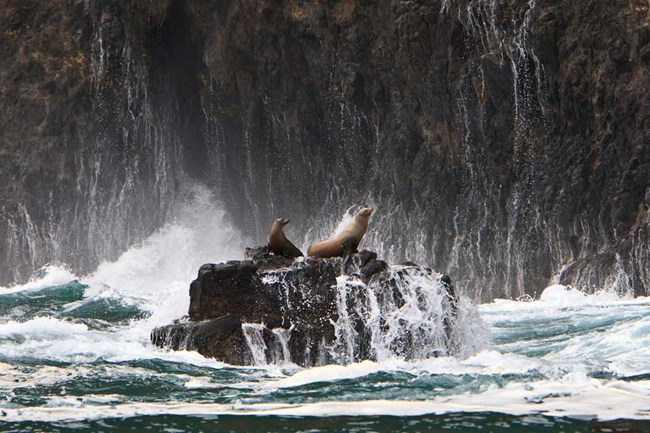
Channel Islands National Park and Marine Sanctuary provide habitat for significant breeding populations of four species of pinnipeds (California sea lions, northern fur seals, harbor seals and northern elephant seals). These species may be viewed during a channel crossing or from various locations on the islands, including:
Walking to Point Bennett on the western tip of San Miguel Island requires some stamina, for it is a fifteen-mile roundtrip hike. About halfway across the island, however, there is something that will help spur you on and encourage your feet to keep moving. That something is a sound-faint at first, but gradually getting louder and louder. The noise is a sort of rumble, low and rolling. What can be making this strange sound? As you come over the rise at Point Bennett you find your answer. There are thousands of elephant seals on the beach-flipping up sand over their huge torpedo-shaped bodies, moving like globs of JELLO over the sand, and carving out territories to call their own. The originators of the noise that you have been listening to are the gigantic males with their long proboscises that give the species its name. You are witnessing a timeless ritual of which sound is just a small part. The elephant seal is one of four species of pinniped (or "wing or feather-footed") marine mammals that are commonly sighted at San Miguel Island. Other species include California sea lions, northern fur seals, and harbor seals. At one time, two other species were found here in abundance--Steller or northern sea lions and Guadalupe fur seals. While only an occasional male Steller sea lion has been seen since the 1980s, a few Guadalupe fur seals have occassionally pupped. Nevertheless, not only are more species sighted at this remote island than at anywhere else on the planet, but this gathering represents one of the largest congregations of wildlife in the world. Staggering populations of over 70,000 California sea lions, 5,000 northern fur seals, 50,000 northern elephant seals and 1,100 harbor seals breed and pup on the island each year. The diversity of pinnipeds is part of a larger picture of biological diversity found in the Santa Barbara Channel. San Miguel Island lies in an area of water that overlaps two currents-a cold current moving down the Pacific coast from Alaska and a warm current moving up the Pacific coast from Mexico. Those two currents meet and intermingle not only water, but many of the species associated with corresponding cold and warm currents. Islands also bring diversity by providing shelf areas where sunlight can penetrate the water, and plants, such as the giant bladder kelp, can grow. The dense kelp forests around the islands provide food and shelter for many varieties of plants and animals. Diversity is also linked to upwelling conditions that exist near San Miguel Island. Upwelling sucks cold nutrient-rich water that normally lies at the bottom of the ocean to the surface, providing food for hundreds of species. Finally, the isolation of the islands also plays a role. A beach all to themselves with no disturbance from people must be very enticing for seals and sea lions. Therefore, the Santa Barbara Channel, the islands, and Point Bennett, specifically, provide all the necessary ingredients that they need--wide sandy beaches, plenty of food, and others of their kind. Researchers from the National Marine Fisheries Service, in cooperation with the park, have been studying the seals and sea lions of San Miguel since 1968. Long-term behavior studies on marked animals provide information about reproductive behavior as well as migratory and feeding patterns. Current studies focus on population assessment and demographics, diseases, and parasites. These pinnipeds are protected by spending at least part of their lives in a national park-or are they? Some threats to these animals know no boundaries. Threats made by water pollution, plastics and debris in the ocean, gill net entanglement, oil spills, overharvesting of fisheries, toxins, and pesticides affect even isolated areas like Point Bennett. These threats can also affect people. Without protection, the spectacular rituals performed on the beaches of Point Bennett can become a thing of the past. Generations to come may only experience the grandeur of Point Bennett through stories and photographs. People can make sure pinnipeds of the park and world survive into the future. Simple things like recycling plastics can make a difference to a curious young sea lion looking for something to play with. That plaything does not need to be a piece of plastic webbing that may strangle it. The most important action people can take is to visit Point Bennett. Discover the world of the pinnipeds for yourself-then tell others how important it is to keep the rituals continuing. Rangers lead guided walks out to Point Bennett during the summer months. For more information on visiting San Miguel Island please click here. |
Last updated: May 26, 2016
